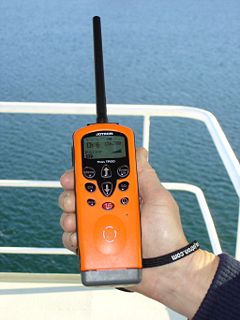
The VESA Local Bus was a short-lived expansion bus introduced during the i486 generation of x86 IBM compatible personal computers. Created by VESA the VESA Local Bus worked alongside the then dominant ISA bus to provide a standardized high-speed conduit intended primarily to accelerate video (graphics) operations. VLB provided a standardized "fast path" that add-in (video) card makers could tap for greatly accelerated memory-mapped I/O and DMA, while still using the familiar ISA bus to handle basic device duties such as interrupts and port-mapped I/O.

Digital Visual Interface (DVI) is a video display interface developed by the Digital Display Working Group (DDWG). The digital interface is used to connect a video source, such as a video display controller, to a display device, such as a computer monitor. It was developed with the intention of creating an industry standard for the transfer of digital video content.
VESA (/ˈviːsə/), formally known as Video Electronics Standards Association, is a technical standards organization for computer display standards. The organization was incorporated in California in July 1989 and has its office in San Jose, California. It claims a membership of over 225 companies.
VESA BIOS Extensions (VBE) is a VESA standard, currently at version 3, that defines the interface that can be used by software to access compliant video boards at high resolutions and bit depths. This is opposed to the "traditional" int 10h BIOS calls, which are limited to resolutions of 640×480 pixels with 16 color (4-bit) depth or less. VBE is made available through the video card's BIOS, which installs during boot up some interrupt vectors that point to itself.
VESA Display Power Management Signaling is a standard from the VESA consortium for power management of video monitors. Example usage includes turning off, or putting the monitor into standby after a period of idle time to save power. Some commercial displays also incorporate this technology.
Extended Display Identification Data (EDID) is a metadata format for display devices to describe their capabilities to a video source. The data format is defined by a standard published by the Video Electronics Standards Association (VESA).
The Display Data Channel, or DDC, is a collection of protocols for digital communication between a computer display and a graphics adapter that enable the display to communicate its supported display modes to the adapter and that enable the computer host to adjust monitor parameters, such as brightness and contrast.
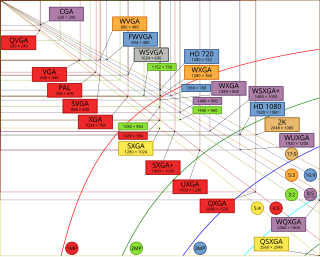
Super Video Graphics Array or Ultra Video Graphics Array, almost always abbreviated to Super VGA, Ultra VGA or just SVGA or UVGA is a broad term that covers a wide range of computer display standards.

HDMI is a proprietary audio/video interface for transmitting uncompressed video data and compressed or uncompressed digital audio data from an HDMI-compliant source device, such as a display controller, to a compatible computer monitor, video projector, digital television, or digital audio device. HDMI is a digital replacement for analog video standards.
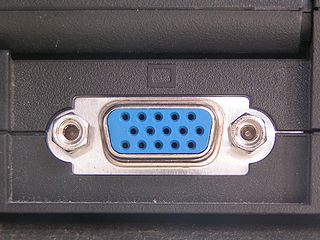
A Video Graphics Array (VGA) connector is a three-row 15-pin DE-15 connector. The 15-pin VGA connector was provided on many video cards, computer monitors, laptop computers, projectors, and high definition television sets. On laptop computers or other small devices, a mini-VGA port was sometimes used in place of the full-sized VGA connector.
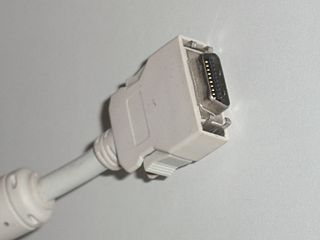
The VESA Digital Flat Panel (DFP) interface standard specifies a video connector and signaling for flat-panel displays. It features 20 pins and uses the PanelLink protocol.

DisplayPort (DP) is a digital display interface developed by a consortium of PC and chip manufacturers and standardized by the Video Electronics Standards Association (VESA). The interface is primarily used to connect a video source to a display device such as a computer monitor, and it can also carry audio, USB, and other forms of data.
The Flat Display Mounting Interface (FDMI), also known as VESA Mounting Interface Standard (MIS) or colloquially as VESA mount, is a family of standards defined by the Video Electronics Standards Association for mounting flat panel monitors, televisions, and other displays to stands or wall mounts. It is implemented on most modern flat-panel monitors and televisions.
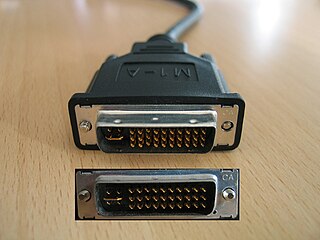
VESA Plug and Display (P&D) is a video connector for digital monitors, such as flat panel displays and video projectors, ratified by VESA. It was introduced around the same time as DFP, marketed as a replacement of VESA Enhanced Video Connector and an extension of DVI. Unlike DVI, it never achieved widespread implementation.
Coordinated Video Timings is a standard by VESA which defines the timings of the component video signal. Initially intended for use by computer monitors and video cards, the standard made its way into consumer televisions.
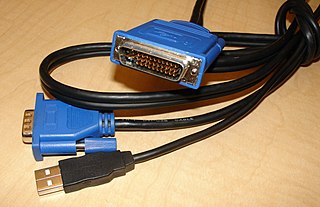
The VESA Enhanced Video Connector is a VESA standard intended to reduce the number of cables around a computer by incorporating video, audio, FireWire and USB into a single cable system. The intention of the system was to make the monitor the central point of connection. Although the specific idea did not find favour with computer manufacturers, it was evolved into the somewhat more popular VESA Plug and Display standard.
Genesis Microchip Inc. was a supplier of integrated circuits (ICs) for video processors in flat panel LCD TVs and Monitors. It was founded in 1987 by Paul Russo in Markham, Ontario, Canada and it became a public company in 1998 and employed over 500 people (2006) worldwide. In 2002, Genesis acquired Sage Inc., a leading supplier of digital display technology. Two years earlier, Sage had acquired Faroudja which was known for its Emmy Award winning video processing technology. Key video processing technology includes: DCDi, MADi, image scaling, color management, LCD response time compensation, and founders of DisplayPort interconnect technology now a VESA standard.
SciTech SNAP is an operating system portable, dynamically loadable, native-size 32-bit/64-bit device driver architecture. SciTech SNAP defines the architecture for loading an operating system neutral binary device driver for any type of hardware device, be it a graphics controller, audio controller, SCSI controller or network controller. SciTech SNAP drivers are source code portable between different microprocessor platforms, and the binary drivers are operating system portable within a particular microprocessor family.
DisplayID is a VESA standard for metadata describing display device capabilities to the video source. It is designed to replace E-EDID standard and EDID structure v1.4.
VESA Monitor Command Control Set or MCCS is a computer standard developed by Video Electronics Standards Association. It defines a binary protocol for controlling the properties of computer monitors from a host device such as PC, set-top box, etc.


